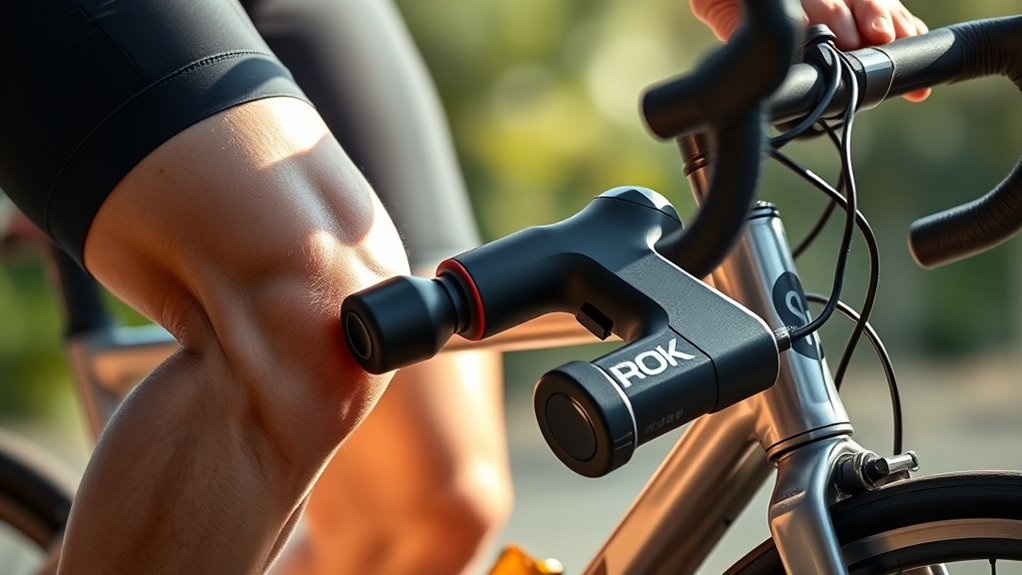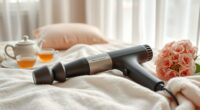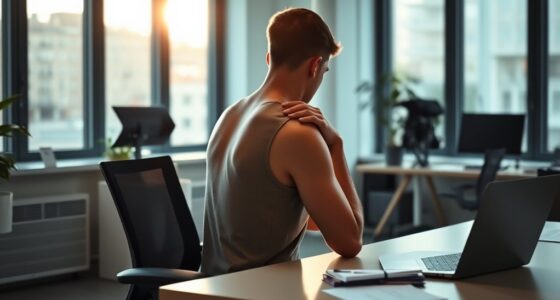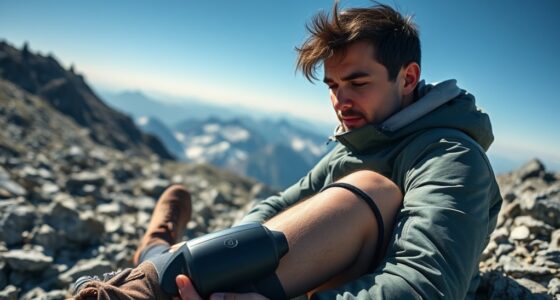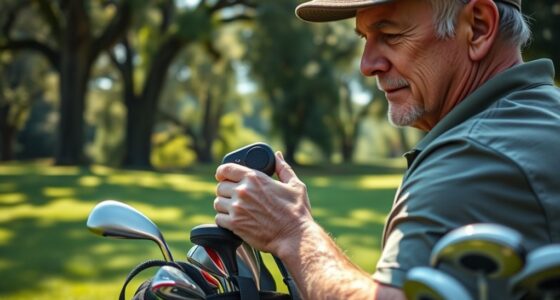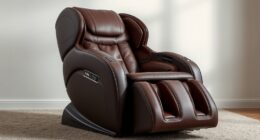Using a massage gun can help you prevent saddle soreness and leg fatigue by targeting tight muscles like quads, hamstrings, calves, and glutes. It promotes better blood flow, reduces soreness, and speeds up recovery, so you feel less discomfort during and after rides. Applying it with gentle, circular motions shortly after cycling can keep your muscles supple and injury-free. Stick with it consistently, and you’ll discover how it supports your cycling performance and comfort over time.
Key Takeaways
- Target key leg and saddle-related muscles to loosen tightness and improve flexibility, reducing soreness during and after cycling.
- Use massage guns promptly after rides to accelerate muscle recovery and prevent overuse injuries.
- Apply gentle, circular percussive therapy on quadriceps, hamstrings, calves, and glutes to relieve fatigue.
- Incorporate massage gun sessions into your routine to maintain muscle suppleness and decrease the risk of chronic injuries.
- Regular use supports faster recovery, enhances performance, and helps prevent saddle soreness and leg fatigue over time.
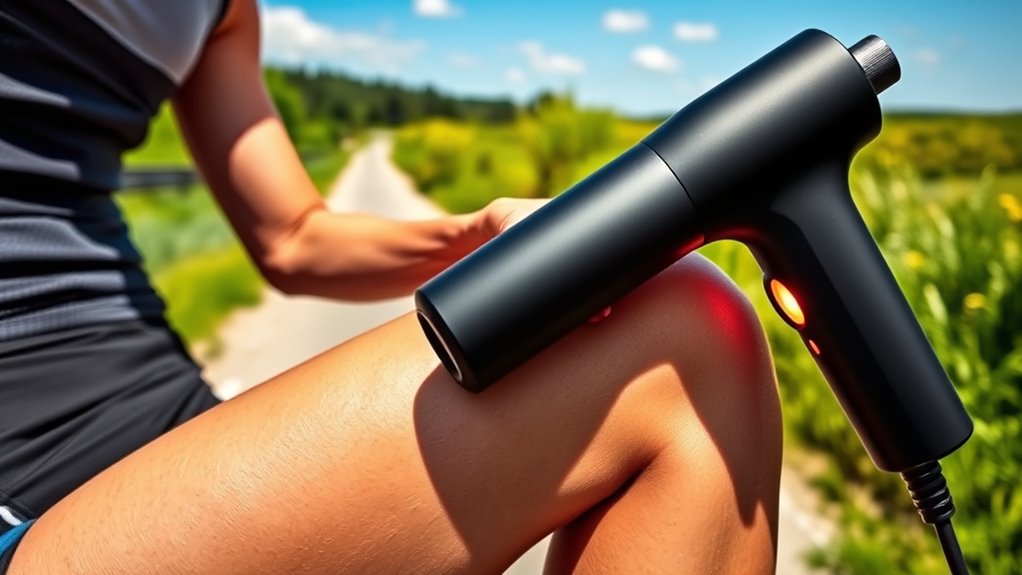
Ever wonder how cyclists can recover faster and prevent injuries after long rides? The answer often lies in effective muscle recovery techniques, and one popular method gaining momentum is the use of massage guns. These handheld devices deliver rapid, targeted percussive therapy to sore muscles, helping you bounce back quicker so you’re ready for your next ride. When used properly, massage guns can markedly enhance your recovery process, reduce soreness, and even prevent injuries that might sideline you for days or weeks. They work by increasing blood flow to tired muscles, which accelerates the removal of metabolic waste products and supplies fresh oxygen and nutrients. This results in faster muscle repair and reduces the risk of overuse injuries, common among avid cyclists.
Preventing saddle soreness and leg fatigue is essential for maintaining consistent performance, and massage guns can play a key role here. By targeting your quadriceps, hamstrings, calves, and glutes, you can loosen tight muscles and improve flexibility. This not only alleviates discomfort during rides but also helps prevent overuse injuries caused by repetitive strain. Regular use after rides ensures your muscles stay supple and less prone to strain, which is necessary for injury prevention. Many cyclists find that incorporating massage guns into their post-ride routine helps them recover more thoroughly, reducing the likelihood of developing chronic issues like tendinitis or muscle strains.
Using a massage gun isn’t complicated, but it does require some knowledge to maximize its benefits. Always start with a low intensity setting and gradually increase as your muscles adapt. Focus on specific areas that feel tight or sore, moving the device in slow, circular motions. Avoid applying excessive pressure, especially over bony areas or sensitive spots, to prevent bruising or discomfort. Consistency is key—make it a habit to use your massage gun within 30 minutes of finishing your ride. This ensures your muscles are treated while they’re still warm and more receptive to recovery efforts. Over time, you’ll notice less soreness after rides and an overall improvement in your muscle flexibility and strength.
Ultimately, integrating a massage gun into your recovery routine can be a game-changer. It supports muscle recovery by reducing inflammation and speeding up healing, which is essential for maintaining a strong, injury-free cycling routine. By taking proactive steps to care for your muscles, you’re less likely to encounter setbacks caused by fatigue or strain. Whether you’re a casual rider or a competitive cyclist, a massage gun can help you stay consistent, comfortable, and injury-free on your cycling journey.
Frequently Asked Questions
Can Massage Guns Improve Overall Cycling Endurance?
Using a massage gun can boost your cycling endurance by promoting muscle relaxation and enhancing blood circulation. When you target tight or fatigued muscles, it helps reduce soreness and speeds up recovery. Better blood flow delivers more oxygen and nutrients to your muscles, allowing you to ride longer and more efficiently. Incorporating regular massage gun sessions into your routine can keep your muscles in ideal condition, ultimately improving your overall cycling performance.
Are Massage Guns Safe for All Skin Types?
You might wonder if massage guns are safe for all skin types. While generally safe, you should consider skin sensitivities and follow safety precautions. If you have sensitive skin or skin conditions, start with a low setting and avoid prolonged use. Always test on a small area first, and consult a dermatologist if you notice irritation. Taking these steps helps guarantee safe, effective relief without risking skin reactions.
How Often Should Cyclists Use a Massage Gun?
You should use a massage gun 3 to 4 times a week to help with muscle tightness and soreness relief. After intense rides or workouts, using it for 1-2 minutes per muscle group can prevent soreness and improve recovery. Avoid overusing it, as too much can cause irritation. Listen to your body, and adjust frequency based on how your muscles respond and feel after each session.
Do Massage Guns Help With Recovery From Crashes?
Crash recovery isn’t just about rest; massage guns can aid your recovery by promoting muscle relaxation and injury prevention. While they don’t replace medical treatment, they help reduce soreness and improve blood flow, speeding up healing. Using a massage gun after a crash can ease muscle tension, prevent further injury, and get you back on your bike faster. It’s a proactive way to support your body through the healing process.
Can Massage Guns Replace Professional Physiotherapy?
You might wonder if massage guns can replace professional physiotherapy, but they shouldn’t. While massage guns are great for self-treatment techniques and can help ease muscle tension, they don’t offer the thorough assessment and tailored treatment that physiotherapy provides. Physiotherapy integration ensures you address underlying issues effectively. Use massage guns as a supplement, not a substitute, to your physiotherapist’s advice and treatment plan for ideal recovery.
Conclusion
So, the next time you hit the road, remember that a massage gun might just be your secret weapon against saddle soreness and leg fatigue. It’s funny how a simple tool can make such a difference, almost like it was made for cyclists like you. By incorporating it into your routine, you’ll find yourself riding longer, feeling stronger, and enjoying each pedal stroke even more. Sometimes, the right tool appears just when you need it most—don’t miss out.
